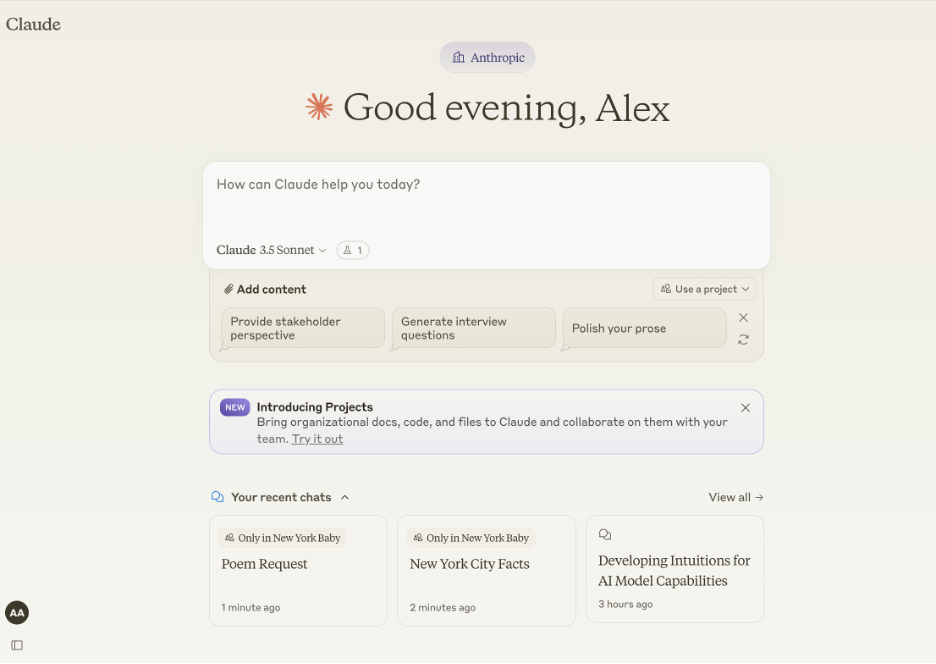AI That Thinks Like You: How Cutting-Edge Technology is Reading Minds and Redefining Automation
Artificial Intelligence (AI) is advancing faster than ever, and the line between human thinking and machine intelligence is becoming thinner. What once seemed like science fiction machines that can think, predict, and even act like humans (Its nice if you remembered Jarvis or Friday) is now becoming a reality. The idea of AI that "thinks like you", no longer just a dream. It’s here, and it’s changing how we work, live, and interact with the technology.
In this blog, we’ll explore how AI is learning to think like humans, the tools making this possible, and how it’s changing industries. We’ll also look at real-world examples of tools which are helping us to automate tasks.
The Rise of AI That Understands You
For years, AI has been great at doing specific tasks, like recognizing faces, translating languages, or analyzing data. But these systems often lacked the ability to truly "understand" what they were doing. Now, a new type of AI is emerging that can think, reason, and make decisions more like humans. This is called cognitive AI.
Cognitive AI uses advanced techniques like deep learning and natural language processing (NLP) to:
- Understand context: It can figure out the meaning behind words, actions, or situations.
- Learn and improve: Instead of following fixed rules, it can learn from new information and get better over time.
- Think like humans: By studying patterns in human behavior, it can predict what people might do or want.
This shift from simple task-based AI to AI that thinks and learns is a big step forward. It’s making machines smarter and more useful in everyday life.
How AI is "Reading Minds”?
The idea of AI reading minds might sound like something out of a sci-fi movie, but it’s becoming real. Scientists and engineers are creating AI systems that can understand brain activity, predict thoughts, and even guess what someone might do next.
-
Brain-Computer Interfaces (BCIs)
Brain-computer interfaces are devices that connect the brain to a computer. They can read brain signals and turn them into actions. For example:
- Neuralink, a company started by Elon Musk, is working on devices that let people control computers or machines with their thoughts. In the future, this could help people with disabilities or even allow communication without speaking.
- Researchers have also created AI systems that can "see" what a person is looking at by analyzing their brain activity. -
Decoding Thoughts
AI can now analyze brain scans to figure out what someone is thinking. By studying brain activity, it can match certain patterns to specific thoughts or emotions. For example:
AI could help people who can’t speak by translating their brain activity into words or actions. -
Understanding Emotions
AI is also learning to recognize emotions by studying facial expressions, voice tones, and even body language. This is already being used in customer service, mental health apps, and even video games to create more personalized experiences.
Changing Automation: From Following Rules to Thinking Ahead
AI that "thinks like you" changing how automation works. Traditional automation systems follow fixed rules and only respond to specific commands. But cognitive AI can think ahead, make decisions, and act without needing constant instructions.
Few interesting case studies -
-
OMI: AI Hardware for Smarter Automation

OMI is an advanced, open-source AI wearable designed to streamline communication and boost productivity. It reads brain signals, transcribes conversations, and manages tasks—acting as an intuitive personal assistant that understands your thoughts and provides relevant suggestions.
How OMI Works -
-
Brain Signal Processing – OMI uses an electroencephalogram (EEG) sensor, detect neural activity and interpret intent, enabling hands-free interaction.
-
Audio Transcription – A built-in microphone captures conversations, converts speech to text, and remembers key details.
-
AI-Powered Assistance – OMI analyzes input to suggest actions, such as creating to-do lists, summarizing discussions, or scheduling events.
Real-World Examples -
-
In Meetings: OMI listens, takes notes, and provides instant summaries, ensuring you never miss key points.
-
Task Management: Thinking about an upcoming deadline? OMI proactively reminds you or schedules a follow-up.
-
Daily Productivity: While brainstorming, OMI suggests relevant insights, helping you refine ideas in real time.
With its intuitive AI integration, OMI transforms how we interact with technology offering smarter, effortless automation.
-
-
OpenAI Operator: Automating Complex Tasks

OpenAI's Operator is an AI agent designed to autonomously perform tasks on the web by interacting with websites much like a human user. It can navigate web pages, fill out forms, click buttons, and handle various online activities on behalf of the user.
GPT-4 generates text from prompts, while Operator enhances this by interacting with web interfaces to perform tasks. Using the Computer-Using Agent (CUA), it combines GPT-4’s vision and reasoning abilities to interpret and interact with graphical user interfaces.
How Operator Works -
Operator operates by remotely controlling a web browser, performing actions such as mouse clicks, scrolling, and typing. It processes visual inputs from web pages and makes decisions to accomplish specified tasks. For critical actions or when sensitive information is involved, Operator seeks user confirmation to ensure safety and accuracy. Currently, Operator is available as a research preview for ChatGPT Pro users in the U.S., with plans to expand access in the future.
Real world Examples -
Online Shopping: Operator can order groceries by navigating to an online store, selecting items, and completing the purchase process.
Travel Arrangements: It can book flights or hotels by interacting with travel websites, filling in necessary details, and finalizing reservations.
Form Completion: Operator can fill out various online forms, such as expense reports or registration forms, by entering information and submitting them on behalf of the user.
-
Claude: AI That Writes Code

Claude AI, developed by Anthropic, is a powerful conversational AI designed to generate text, assist with coding, and even preview web pages. What makes it exciting is its ability to not only write code but also render and display live web pages when working on web development. This feature allows developers to instantly see their generated HTML, CSS, and JavaScript code even the frameworks such as React.js in action, making it an invaluable tool for rapid prototyping and debugging.
With its live web page preview, intelligent reasoning, and ethical AI framework, Claude AI is redefining the way people interact with AI for coding, content, and beyond!
How Claude Works -
Claude is built on advanced deep learning models, designed to understand natural language and generate high-quality responses. Unlike traditional AI assistants, Claude follows a "Constitutional AI" approach, ensuring safe, transparent, and ethical interactions. For web developers, one of its most exciting capabilities is live web previewing—when generating frontend code, Claude can display a fully interactive website preview, allowing users to test layouts, styles, and scripts instantly.
Real world Examples -
Web Development & UI Prototyping – Developers can generate code for landing pages, UI components, and interactive elements while instantly previewing how they look and function.
Content Creation – Writers and marketers use Claude to draft articles, blog posts, and creative content.
Customer Support Automation – Businesses integrate Claude for smart, real-time responses to user queries.
Legal & Research Assistance – Analysts use Claude to summarize legal documents and extract key insights.
Ethical Concerns: The Challenges of Smarter AI
While AI that "thinks like you" exciting, it also raises important questions. As machines become more human-like, we need to think about the risks and challenges.
-
Privacy Issues -
If AI can read thoughts or emotions, how do we make sure this information is used responsibly? Protecting people’s privacy will be a big challenge.
-
Bias in AI -
AI systems learn from data, and if the data is biased, the AI can make unfair decisions. For example, biased data could lead to discrimination in hiring or lending.
-
Over-Reliance on AI -
As AI becomes smarter, people might rely on it too much and lose some of their independence. It’s important to use AI as a tool, not a replacement for human decision-making.
-
Job Loss -
AI that can think and automate tasks might replace some jobs. While it can create new opportunities, it’s important to prepare for the changes it will bring to the workforce.
The Future of AI: Working Together with Machines
The development of AI that “thinks like you” changing how we interact with tech. Instead of just being tools, these systems are becoming partners that can understand, predict, and collaborate with us.
As we move forward, it’s important to balance innovation with ethics. By addressing the challenges and using AI responsibly, we can create a future where humans and machines work together to achieve amazing things.
Real-World Impact: Tools Like OMI, OpenAI Operator, and Claude
The tools we’ve discussed OMI, OpenAI Operator, and Claude are already showing how AI can make life easier and more efficient:
- OMI is an AI-powered wearable that reads brain signals, transcribes conversations, and manages tasks for seamless productivity.
- OpenAI Operator is an AI agent that autonomously interacts with websites to perform online tasks like a human.
- Claude is making it easier for developers to create websites and applications with just a few instructions.
These tools are just the beginning. As AI continues to evolve, it will open up the new possibilities in every field, from education to entertainment to healthcare.
In conclusion, AI that “thinks like you” no longer just an idea, it’s here, and it’s changing the world. By mimicking human thought, tools like OMI, OpenAI Operator, and Claude, etc. are making automation smarter and more personal. As we embrace this new technology, we must also think carefully about how to use it responsibly. The future of AI is bright, and it’s thinking with us, not just for us.
Sources -





